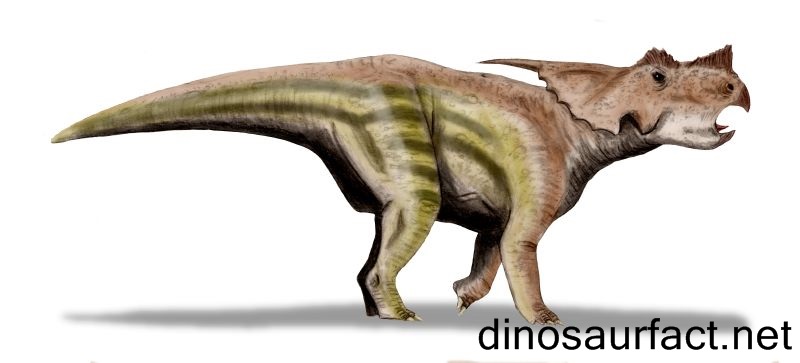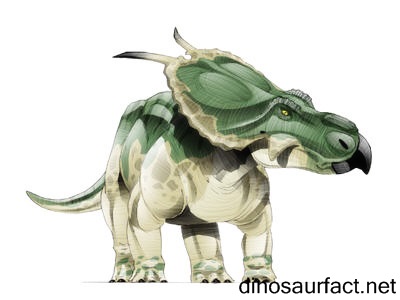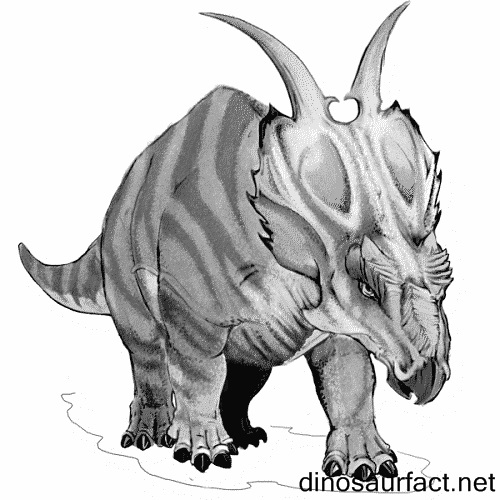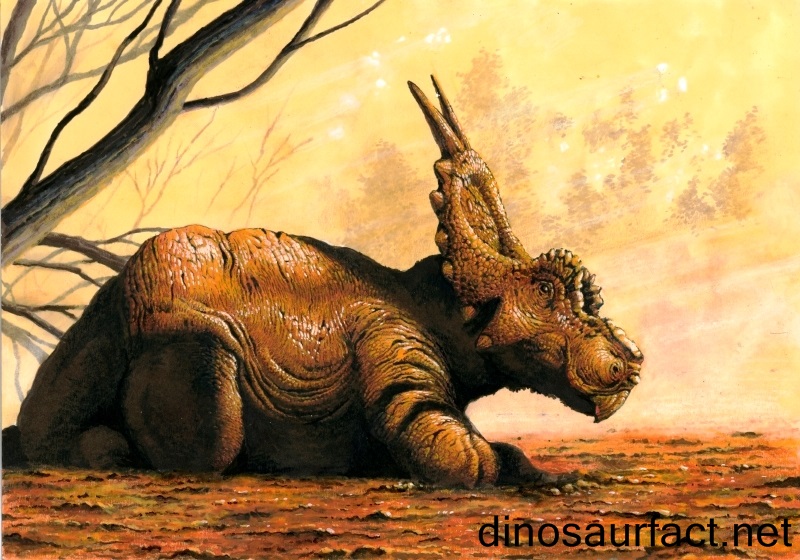 Click to visit the previous dinosaur bio
Click to visit the previous dinosaur bio
 |
|
 |
|
Kingdom: Animalia
Phylum: Chordata
SuperOrder: Dinosauria
Order: Ornithischia
Family: Ceratopsidae
Genus: Achelousaurus
 |
|
 |
|
 |
|

Introduction
The Achelousaurus is dinosaur that existed on the earth in the late Cretaceous Period. The time range of its existence is judged to be between 79 and 60 million years ago. It was a ceratopsid, the same group that includes the better known Triceratops. Like other ceratopsids, it was quadrupedal, i.e. it walked on all four legs. The distinguishing characteristic of the Achelousaurus is the structure if its skull and jaws. Its snout is beak like and the nasal bone bears a thick ridge. It also has two horns situated behind its orbital cavity. Such special structures are seen in all ceratopsids.
The Achelousaurus was medium sized dinosaur. It weighed about two to three tons and its length is expected to be about 6 meters. Its diet was herbivorous and it was likely predated upon by other larger carnivorous theropods.
Etymology
- The name Achelousaurus is a combination of two words. ‘Achelous’ is the name of the patron deity of the Greek river Achelous. According to Greek mythology, he had battled with Hercules over the nymph Deianeira. During this battle, he turned himself into a bull. Hercules ripped off one of his horns and forced him to capitulate.
- The Achelousaurus only has prominent nasal ridge or ‘boss’, whereas another ceratopsid, Einiosaurus, has a fully developed nasal horn. In relation to this ‘lost’ horn, the dinosaur was christened ‘Achelousaurus’. The suffix ‘-saurus’ is derived from the Greek word ‘sauros’, which translates to ‘lizard’ in English. Thus the name Achelousaurus means ‘the lizard of Achelous’.
- The binomial name A. horneri, honors the paleontologist Jack Horner, who led the expedition that led to the discovery of the holotype of the Achelousaurus. The nomenclature was done by scientist Scott Sampson. Most likely, the scientists involved in the naming process recognized the irony of the generic name signifying ‘no horn’ and the specific name having the word ‘horn’ in it, but did not change it as it was still amusing.
The discovery of fossils
The fossils which are attributed to the Achelousaurus were discovered in the Two Medicine formation in Montana in the United States. They were found in the year 1987 and the scientist responsible for the discovery was Jack Horner. They remained unclassified due to certain confounding features on the skull, but they finally found their place in the taxonomic tree in the year 1995, with the help of Scott Sampson.
The nature of fossils
- Three skulls attributed to the Achelousaurus were found in Montana in the initial excavation. A few post cranial bones were also found, but the cranium was enough to recognize the bones as belonging to a ceratopsid.
- The skull of the Achelousaurus is expanded, just like that of other ceratopids.
- It consists of long nasal bones, which form a beak like structure towards their tips.
- The nasal bone also have thick ridge, where other ceratopsids have a boss. Some species do not have any projections on their nasal bones, which makes the ridge appear as though it is the part of a broken horn.
- The posterior part of the skull consists of two frills, which arise from the occipital bones. These frills also possess two long horns.
- The length of the largest of the skulls which were discovered was 1.6 meters, including the length of the horns.
Current location of fossils
The fossils of the Achelousaurus are currently housed in the Museum of the Rockies in Bozeman, which is located in Montana.
Classification
The Achelousaurus is an ornithischian, or ‘bird-hipped’ dinosaur. It is classified under family Ceratopsidae, sub family Centrosaurinae, tribe Pachyrhinosaurini and clade Pachyrostra.
The classification of this dinosaur has been a matter of debate. Some scientists believe that it is an intermediate species between the Pachyrhinosaurus and the Einiosaurus. The Pachyrhinosaurus does not have a nasal horn, while the Einiosaurus has large and curved horn on its nasal bone. Other scientists believe that all three or at least two of these dinosaurs are different developmental stages of each other.
While this matter may not be settled till new evidence is uncovered, the Achelousaurus may be considered a separate genus till then.
The Two Medicine Formation
The Two Medicine Formation is a natural geological rock structure located in Montana, USA. It consists of fossils from the Campanian age of the Cretaceous period. It is composed primarily of sandstone, which was deposited there by streams, rivers and other such water bodies.
This formation has uncovered many dinosaur and other reptilian species. The Scolosaurus, Achelousaurus, Cerasinops, Troodon, along with many bivalves, turtles and lizards are some of the fossilized organisms found here.
Physical characteristics
- The Achelousaurus was medium sized dinosaur as compared to its peers. It weighed about 2000 to 4000 kilos and was about 20 feet in length.
- The head of this dinosaur was very large. It had a stout prominence on its nasal bone, along with having a fan like frill and two large horns towards the posterior side of its head.
The function of these horns unknown. They possibly could be secondary sexual characters or they might be used as offensive and defensive tools.
- It had a protruding snout.
- Like other ceratopsids, the Achelousaurus had short and stout legs, which were similar in size.
- It has a stout tail.
Habits and habitat
The Achelousaurus was herbivorous dinosaur and obtained its nourishment from low lying bushes and shrubs. It is unknown whether it could charge at high speeds like the modern day rhinoceros. Ceratopsids are believed to be dinosaurs that lived in herds. But there is no concrete proof backing these claims. Furthermore, some scientists believe that ceratopsids displayed sexual dimorphism. Again, there isn’t enough data to say this with certainty, and the fossils of the Achelousaurus do not show the presence of gender differentiation. If the Achelousaurus used its posterior horns for attack, it would need to lower its head so low that it would cease to see its predator. This is unlikely, yet not impossible.
The habitat of this dinosaur consisted of green plains which were intermingled by rivers and lakes.
Related and coexisting species
The Achelousaurus is believed to be closely related to the Einiosaurus and the Pachyrhinosaurus.
Index
Extinct Profiles
 Triassic Dinosaurs
Triassic Dinosaurs Jurassic Dinosaurs
Jurassic Dinosaurs Cretaceous Dinosaurs
Cretaceous Dinosaurs Pterosaurs
Pterosaurs Marine Reptiles
Marine Reptiles Dinosaur Extinction
Dinosaur Extinction